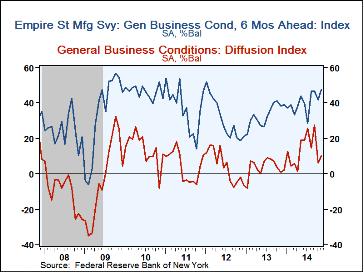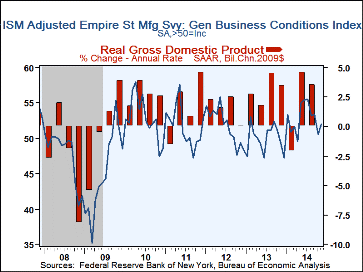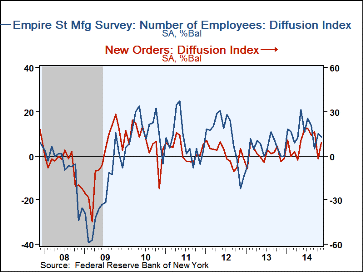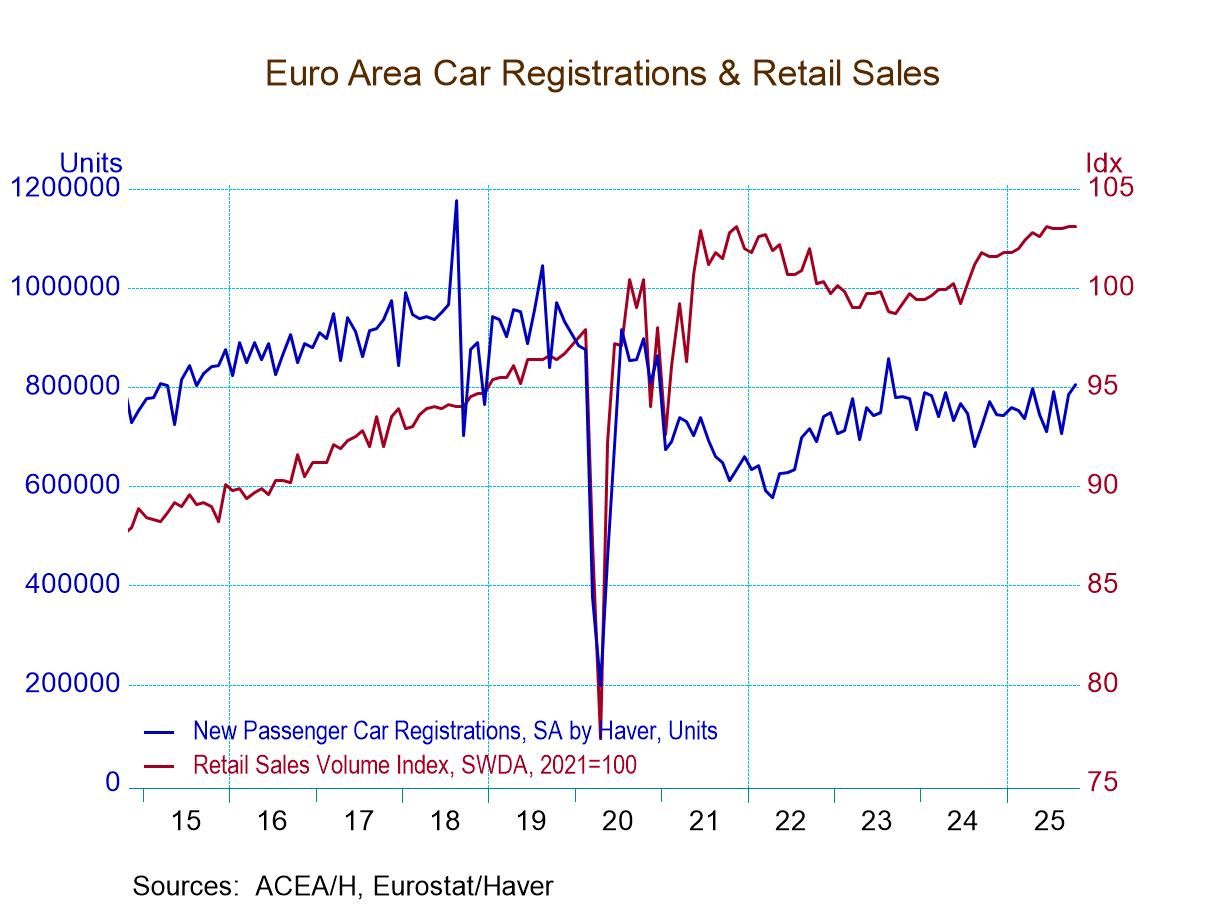 Global| Nov 17 2014
Global| Nov 17 2014Empire State Factory Sector Index Improves
by:Tom Moeller
|in:Economy in Brief
Summary
The Federal Reserve Bank of New York reported that its Empire State Factory Index of General Business Conditions recovered to 10.16 during November following a sharp decline to an unrevised 6.17 in October. Despite the upturn, the [...]
The Federal Reserve Bank of New York reported that its Empire State Factory Index of General Business Conditions recovered to 10.16 during November following a sharp decline to an unrevised 6.17 in October. Despite the upturn, the figure remained near the lowest level since April. It roughly matched expectations for 10.5 in the Action Economics Forecast Survey.
Based on these figures, Haver Analytics calculates a seasonally adjusted index that is compatible to the ISM series. The adjusted figure also gained modestly to 52.0 but remained near the lowest point since April.. A rising level of activity is indicated by a figure above 50. Since inception in 2001, the business conditions index has had a 68% correlation with the quarterly change in real GDP.
The shipments series led the way higher but also remained near the seven month low. New orders also rose moderately. Elsewhere, declines in the component series were widespread. Delivery times slowed and the index remained negative for the fifth straight month, indicating quicker delivery speeds. The employment series gave up a piece of its October improvement and remained well below its May high. During the last ten years there has been a 71% correlation between the index level and the m/m change factory sector payrolls. Unfilled orders and inventories also fell moderately.
The prices paid index fell to the lowest level since July 2012. Six percent of respondents reported paying lower prices, the most since July last year. Seventeen percent realized increased prices, nearly the least since July 2012. During the last ten years, there has been a 70% correlation between the index and the 3-month change in the intermediate goods PPI.
Looking ahead, the Empire State index of expected business conditions in six months recovered sharply to 47.61, its highest level since January 2012. The employment, workweek, new & unfilled orders and inventories series led the rise. Capital expenditures backed away from its recent high while technology spending also fell.
The Empire State figures are diffusion indexes which are calculated by subtracting the percent of respondents reporting poorer business conditions from those reporting improvement. Thus, they have a good correlation with growth in the series covered. The data is available in Haver's SURVEYS database. The ISM-adjusted headline index is calculated by Haver Analytics. The series date back only to 2001. The Consensus expectation figure can be found in Haver's AS1REPNA database.
Measuring Labor Market Slack: Are the Long-Term Unemployed Different? from the Federal Reserve Bank of New York can be found here.
| Empire State Manufacturing Survey | Nov | Oct | Sept | Nov'13 | 2013 | 2012 | 2011 |
|---|---|---|---|---|---|---|---|
| General Business Conditions (ISM Adjusted) | 52.0 | 50.6 | 53.4 | 49.3 | 50.0 | 51.8 | 51.8 |
| General Business Conditions (Diffusion Index, %) | 10.16 | 6.17 | 27.54 | 0.83 | 3.82 | 4.29 | 4.48 |
| New Orders | 9.14 | -1.73 | 16.86 | -3.46 | 1.13 | 1.47 | 4.04 |
| Shipments | 11.83 | 1.12 | 27.08 | 1.46 | 4.49 | 11.22 | 9.47 |
| Unfilled Orders | -7.45 | -4.55 | -10.87 | -17.11 | -8.74 | -8.83 | -5.29 |
| Delivery Time | -9.57 | -5.68 | -5.43 | -3.95 | -3.52 | -0.30 | -0.91 |
| Inventories | 0.00 | 2.27 | -7.61 | -1.32 | -5.73 | -2.91 | -1.80 |
| Number of Employees | 8.51 | 10.23 | 3.26 | 0.00 | 3.73 | 8.62 | 6.68 |
| Prices Paid | 10.64 | 11.36 | 23.91 | 17.11 | 21.53 | 24.71 | 40.66 |
Tom Moeller
AuthorMore in Author Profile »Prior to joining Haver Analytics in 2000, Mr. Moeller worked as the Economist at Chancellor Capital Management from 1985 to 1999. There, he developed comprehensive economic forecasts and interpreted economic data for equity and fixed income portfolio managers. Also at Chancellor, Mr. Moeller worked as an equity analyst and was responsible for researching and rating companies in the economically sensitive automobile and housing industries for investment in Chancellor’s equity portfolio. Prior to joining Chancellor, Mr. Moeller was an Economist at Citibank from 1979 to 1984. He also analyzed pricing behavior in the metals industry for the Council on Wage and Price Stability in Washington, D.C. In 1999, Mr. Moeller received the award for most accurate forecast from the Forecasters' Club of New York. From 1990 to 1992 he was President of the New York Association for Business Economists. Mr. Moeller earned an M.B.A. in Finance from Fordham University, where he graduated in 1987. He holds a Bachelor of Arts in Economics from George Washington University.










